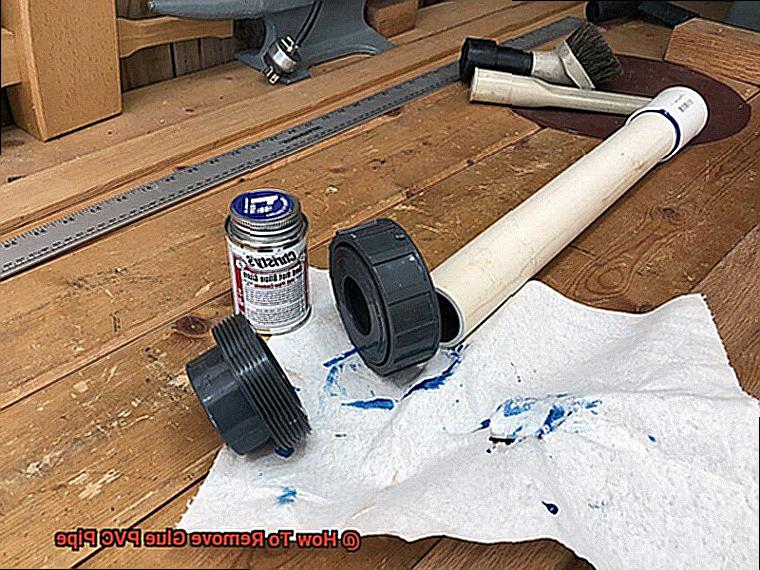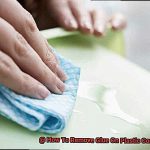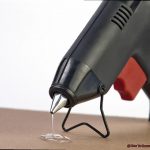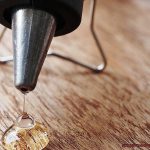Have you ever been in a sticky situation where you needed to remove glue from a PVC pipe?
Maybe you were trying to fix a leak but ended up with excess glue, or perhaps you accidentally glued pieces together that weren’t meant to be joined. Whatever the case may be, removing glue from PVC pipes can seem like an insurmountable task.
But don’t fret. In this blog post, we’re going to delve into everything you need to know about how to remove glue from PVC pipes.
First things first, let’s talk about why you might want to remove glue from a PVC pipe and the consequences of not doing so. We’ll also explore the different methods for removing glue, including using solvents, heat, or mechanical means like sanding or scraping.
You’ll learn which methods are the safest, most efficient, and most appropriate for each situation. But wait, there’s more.
We’re also going to provide you with some useful tips and tricks to make the process easier. For example, wearing gloves and safety goggles can protect your skin and eyes from harmful chemicals.
And being patient and cautious with each step is crucial for achieving the best results. By the end of this post, you’ll have all the knowledge and confidence needed to tackle even the toughest glue removal jobs on PVC pipes.
So, let’s get started.
Identifying the Type of Glue Used on PVC Pipe
Contents
The key to successful removal is identifying the type of adhesive used on the pipe. When it comes to PVC pipes, there are two commonly used types of glue: solvent-based and water-based.
Solvent-based glue, also known as cement, is the most commonly used adhesive for PVC pipes. It’s a powerful adhesive made up of a mixture of solvents and resins that create a strong bond between the PVC pipes.
To help identify the type of glue used, it comes in different colors like clear, yellow, and blue. On the other hand, water-based glue is a less commonly used alternative to solvent-based glue.
It’s a non-toxic option made up of a mixture of water and resins. Water-based glue is often used when solvent-based glue isn’t appropriate, such as in areas where there’s a risk of fire or in applications that require frequent disassembly.
Identifying the type of glue used on PVC pipe can be done by checking the color of the adhesive. If you’re not sure about the color or if the glue has been painted over, you may need to use a solvent to dissolve the adhesive and reveal its color.
Additionally, checking the label of the product used to bond the PVC pipes together can provide information on whether it’s solvent-based or water-based and instructions on how to remove it safely. Once you’ve identified the type of adhesive used, it’s time for safe and effective removal methods.
Acetone is a popular choice for removing solvent-based glue without damaging the pipe. You can apply it directly to the glue and let it sit for several minutes before scraping or sanding it off.
Heating the pipe with a heat gun or hairdryer can also break down the chemical bonds in the glue, making it easier to remove. If you’re dealing with a particularly stubborn patch of glue, try using a combination of methods like applying acetone and then using heat to soften remaining glue.
However, keep in mind that removing PVC glue can be messy, so it’s important to protect your work area with plastic sheeting or newspaper and wear gloves and safety glasses when handling chemicals or using heat tools.
Using a Chemical Solvent to Remove PVC Glue
DIY enthusiasts and professionals alike use this common method to dissolve the bond between PVC pipe and glue, making it easy to remove. But, safety should always be top priority when handling these powerful solvents.
Chemical solvents like acetone and PVC pipe cleaner are great options for removing PVC glue. Acetone is a potent solvent that can quickly dissolve glue.
Simply apply it to the affected area and let it sit for a few minutes until the glue softens. Then, use a scraper or sandpaper to remove it.
Alternatively, PVC pipe cleaners containing chemical solvents can also break down the glue and make it easier to remove. However, it’s crucial to keep in mind that these solvents can be harmful if not used correctly.

Always use them in well-ventilated areas to avoid inhaling harmful fumes. Additionally, wear gloves and eye protection when using them.
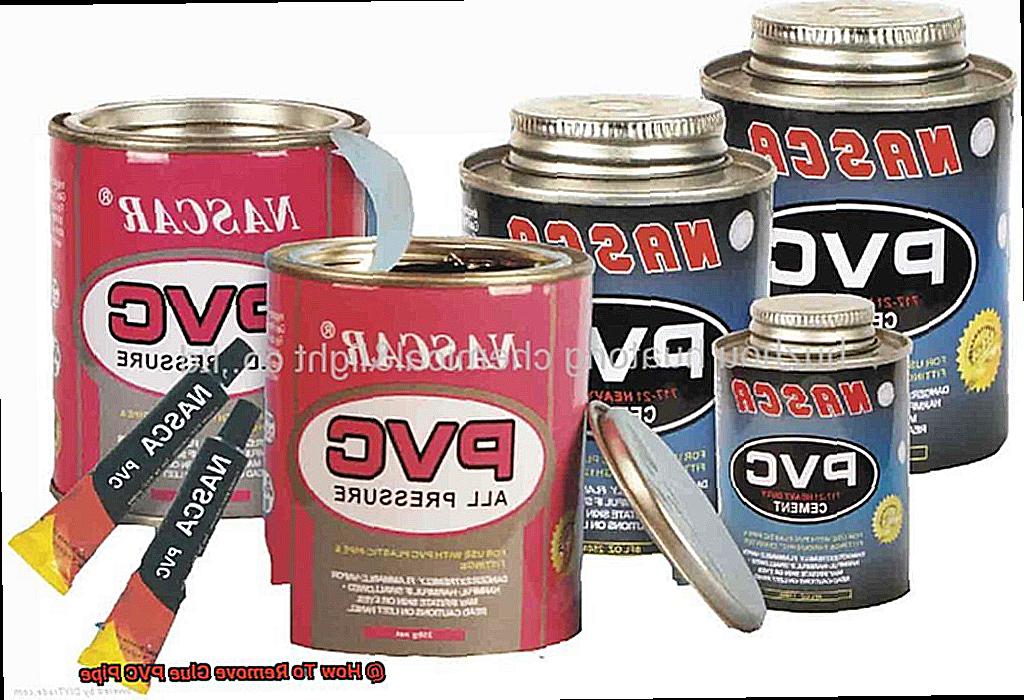
These simple safety measures can make a big difference in keeping you safe while using these solvents. Remember to follow the manufacturer’s instructions when using chemical solvents to remove PVC glue.
Seek professional advice or guidance if you’re unsure about how to use them safely. In conclusion, using chemical solvents is an effective solution for removing PVC glue, but safety should always be your top priority.
Heating the Pipe to Break Down the Glue
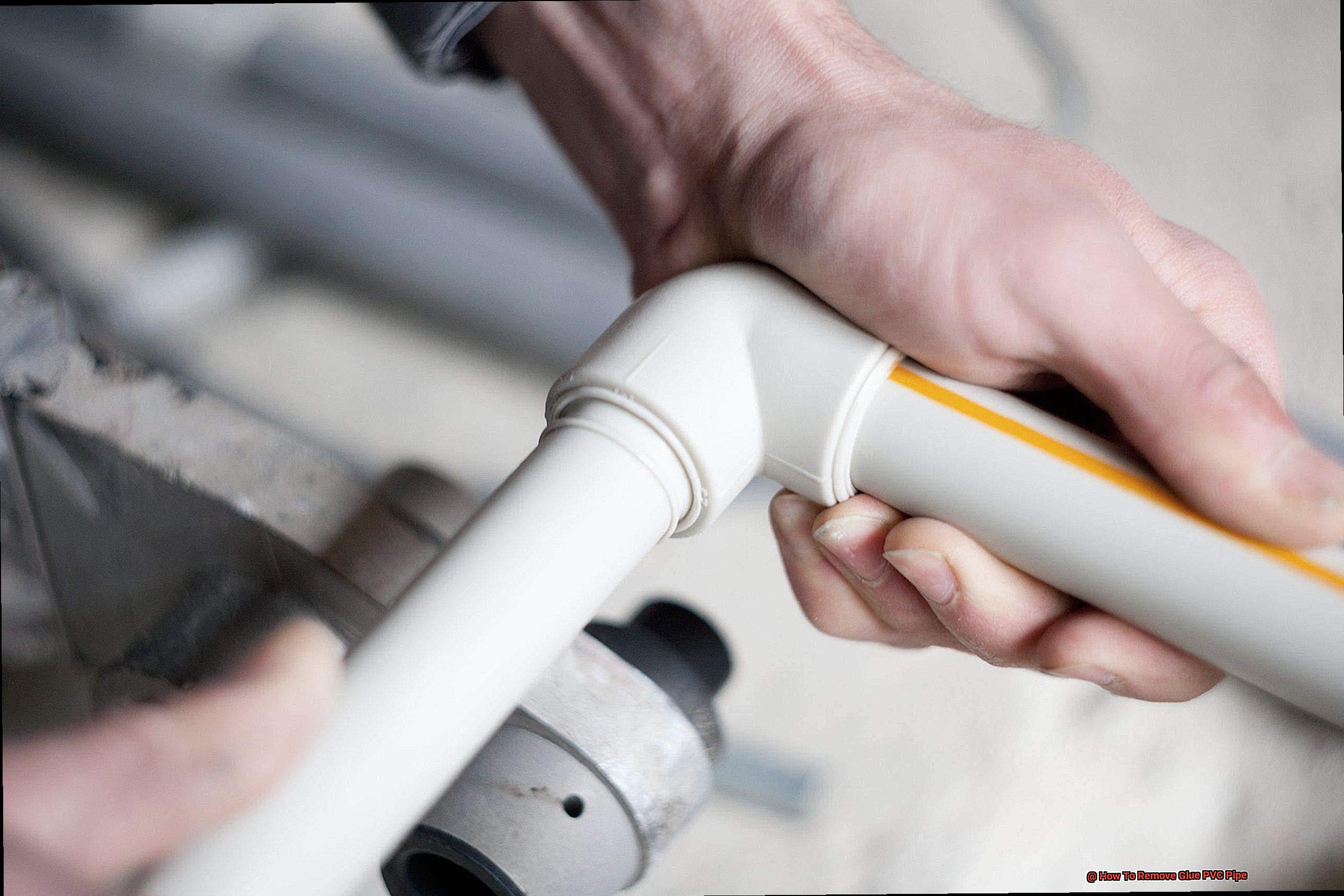
There’s a simple and effective solution – heating the pipe to break down the glue.
This method works by softening and breaking down the glue, allowing for easy removal of the pipes. To begin, plug one end of the pipe and pour boiling water into the other end.
The hot water will soften the glue, making it easier to remove. For larger pipes, a heat gun or propane torch can be used to heat up the area around the glued connection.
However, it’s important to exercise caution during this process. Overheating the pipe can cause damage to the PVC material, so keep the heat source moving around the glued area, ensuring that it is evenly heated.
Once the glue has softened and broken down, carefully use pliers or a wrench to twist and pull apart the pipes. Protective gear such as gloves and goggles are essential when using this method.
Additionally, make sure there are no flammable materials nearby when using a propane torch.
Combining Methods for Stubborn Patches of Glue
Removing stubborn patches of glue from PVC pipes can be a daunting task, but with the right combination of methods, it can be a breeze.
In this post, we’ll explore how to use a combination of heat and solvents to tackle even the most stubborn glue residue on your PVC pipes. To begin, you’ll want to apply heat to the glued area using a heat gun or hair dryer on high setting.
The heat will soften the glue, making it easier to remove. It’s essential to work in a well-ventilated area and wear protective gloves to prevent any potential harm.
Once the glue has been softened by the heat, you can apply a solvent such as acetone or MEK (methyl ethyl ketone) to further break down the adhesive bond. Use a soft cloth or brush to apply the solvent carefully and let it sit for a few minutes.
After the solvent has had time to work its magic, you can use a scraper or sandpaper to gently remove the glue residue. Repeat this process as many times as necessary until all of the glue is removed.
It’s crucial to remember that solvents can be hazardous if not used properly. Always follow safety guidelines and manufacturer instructions when working with solvents.
In addition to heat and solvents, other techniques such as sanding, scraping, or using a rotary tool can also be effective for removing stubborn patches of glue on PVC pipes. Don’t be afraid to experiment with different methods until you find what works best for your specific situation.
By using a combination of heat and solvents, you can successfully remove even the most stubborn glue residue from your PVC pipes.
Protecting Your Work Area When Removing PVC Glue
Removing PVC glue from pipes or other surfaces can be a messy and potentially hazardous task.
That’s why it’s crucial to protect your work area and yourself while performing this job. Here are some essential tips to follow that will help you safely remove PVC glue and keep your work area clean:
First and foremost, make sure to wear the proper protective gear. Gloves will protect your skin from any contact with the glue or chemicals you may use during the removal process, while eye protection will prevent splashes from getting into your eyes.
Next, cover your work surface with a protective material like a drop cloth or plastic sheeting. This will prevent any drips or spills from damaging your work area and make it easier to clean up afterward.
It’s also a good idea to have a container nearby to catch any excess glue or chemicals that might spill during the removal process. This container will keep your work area tidy and prevent any accidents.
Proper ventilation is essential when working with PVC glue. Fumes from the glue and chemicals can be harmful to your health, so open windows or doors or use a fan to circulate air in your work area.
Finally, make sure to dispose of all materials used in the removal process properly. Check with your local waste management facility for correct disposal methods for gloves, drop cloths, and containers used for excess glue or chemicals.
A0VShsPUu48″ >
Also Read: How to Glue Brass to PVC?
Conclusion
In conclusion, removing pesky glue from PVC pipes may seem like an intimidating task, but fear not.
With the right knowledge and techniques, it can be done safely and effectively. The first step is to identify the type of glue used before attempting to remove it.
Once you know what you’re dealing with, you can use the appropriate method for each situation. Chemical solvents such as acetone or PVC pipe cleaner are excellent options for dissolving glue.
However, safety should always come first when handling these powerful substances. It’s crucial to wear gloves and eye protection, cover surfaces with protective materials, ensure proper ventilation, and dispose of materials correctly.
Another effective method is heating the pipe to soften the glue for easy removal. But don’t get too carried away – overheating can damage your PVC material.
If you encounter stubborn patches of glue that refuse to budge, combining methods like heat and solvents or sanding and scraping can work wonders. Remember that patience is key when removing glue from PVC pipes.
Take your time and prioritize safety at all times. By following these tips and tricks, you’ll soon become a pro at removing PVC glue.
In summary, whether you’re a DIY enthusiast or a professional plumber, knowing how to remove glue from PVC pipes is an essential skill to have in your toolbox.

